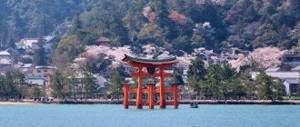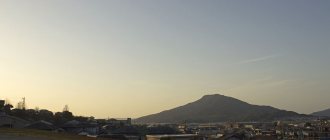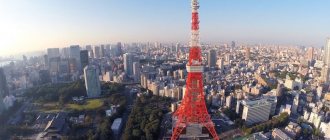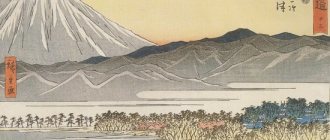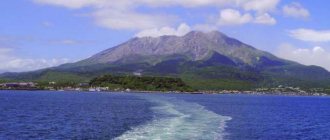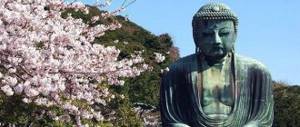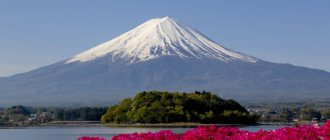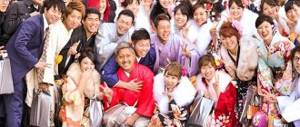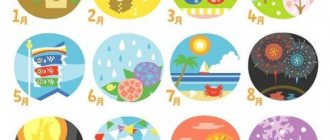Watch the sunrise at the top of Mount Fuji
Honshu Island
Click on the photo for cheap tickets to Tokyo
Every Japanese dreams of climbing Mount Fuji at least once in their life: its snow-covered cone has long become the main symbol of the country. Several routes lead to the top of the dormant volcano; you can go through them from July to September. Take a warm jacket, a cane, onigiri rice balls for a snack - and go ahead, conquer the sacred Fuji. If you are a beginner, it is better to spend the night in a mountain hut halfway and start to the top before dawn. The climb is not easy, but the fabulous sunrise above the white feather-bed of clouds will be remembered for a lifetime.
There are two main options for climbing Mount Fuji: leaving in the evening and without rest, or leaving between 12:30 and 14:00 and spending the night in a hut at stations 7-8-9. Both options involve meeting dawn (4-5 am) at the top.
If you don’t have the energy and time to climb, it’s better to stay at the foot and admire Fuji from the Five Lakes region. When, in cloudless weather, the top opens in all its glory, all the surrounding artists grab their brushes and draw “sakasa fuji”, translated as an inverted reflection of Fuji on the surface of the water.
Horyuji Temple
Horyu-ji Temple was built by Prince Shotoku in 607, but was soon destroyed and rebuilt in 711. Horyu-ji Temple is Japan's oldest temple and is a national treasure. In addition, this is the oldest structure in the world made of wood. The temple consists of a main hall and five pagodas surrounding it.
Watch out for a geisha
Kyoto city
Click on the photo to open cheap flights to Japan in a new tab
Photographs of the Gion quarter in the heart of ancient Kyoto can be used to illustrate books about medieval Japan. It’s truly atmospheric here: there are wooden houses all around with slits-windows made of rice paper, humpbacked bridges spanning streams and graceful silhouettes in the dim light of lanterns. In the labyrinth of narrow streets, you are sure to meet an apprentice geisha, mincing about her business. Tourists here can be turned into one of them: dressed in a kimono, whitened their face and a breeze ride on a cart pulled by a muscular rickshaw.
If you're willing to splurge, in authentic tea houses like Ichiriki, geishas entertain guests with graceful dancing and playing the three-stringed shamisen. A slightly cheaper program is at the Gion Corner cultural center, where, as a bonus in addition to dancing and singing, they teach the tea ceremony and ikebana.
Don't miss: Where to learn unusual skills
Find low-cost flights to Japan
Find a cheap hotel in Japan
Admire the cherry blossoms
Tokyo city
To see Japanese cherry blossoms in bloom, take cheap tickets to Tokyo for spring
The Japanese have a great sense of beauty: it’s not for nothing that they have elevated admiring cherry blossoms to a special cult. You can watch fragile petals slowly swirling in the wind for only a couple of weeks a year. In mid-April, the buds bloom in Tokyo, enveloping the city in a soft pink cloud. To capture sakura on the surface of the water, take a boat ride along the flowering banks of the Sumida River or rent a boat in Chidorigafuchi Park. In Tokyo's Ueno and Eegi parks, noisy picnics do not stop until late in the evening, when the trees are illuminated with colorful lights.
At the height of cherry blossoms, the resort region of Hakone is incredibly beautiful. Be sure to take a classic shot with pink branches against the snow-white cone of Fuji.
What else to do in the capital of Japan: 8 ways to see Tokyo from different angles
Find cheap flights to Tokyo
Find a cheap hotel in Tokyo
Historical monuments of ancient Nara (Temple City: Historic Nara)
Nara was the capital of Japan from 710 to 784. The city's historical sites - Buddhist temples, Shinto shrines and the excavated remains of a large imperial palace - provide a vivid insight into life in the Japanese capital in the 8th century, a period of profound political and cultural change in the country.
Nara is the birthplace of Japanese culture. Nara, the cradle of Japanese culture and the spiritual home of the Japanese people, maintains a beautiful harmony between history and nature.
Descend to the underworld
Kyushu Island
At the Japanese spa resort of Beppu, eight hot springs with the prefix “jigoku”, which means “hell” in Japanese, boil and bubble. What looks most like hell is a blood-red source spewing out clouds of steam. There is a horror story that you can be boiled alive here - no wonder, because the water temperature is about +80 °C.
Holidays at the springs of Kyushu Island are unusual. Every half hour a geyser erupts nearby, bubbles of mud gurgle here and there, and you know your feet are steaming in a hot bath. Spa treatments not far from the underworld are appropriate: guests are wrapped in a sheet and buried in healing black sand. If you work up an appetite, you can refresh yourself with eggs boiled in the spring: despite their coffee color, their taste is quite eggy.
More on the topic:
Devilishly scary bridges, observation decks and trails from around the world
13 damn unexpected paradoxes of nature
Find low-cost flights to Japan
Find a cheap hotel in Japan
Sapporo
What to see in winter? Active travelers head to Hokkaido. Ski tourism and hot springs at the foot of the mountains are a merit of nature and the efforts of local authorities. There are other attractions of Sapporo:
- mountain park;
- art park;
- fish market;
- beer museum;
- white chocolate museum;
- hippodrome
What is a must see? Shikotsu-Toya National Park, where the most famous thermal spring is located, attracts 2.5 million tourists annually.
There are buses from the airport to the city.
Lose your voice at a sumo tournament
Tokyo city
The Japanese love for sumo knows no bounds - the entire Ryogoku quarter of Tokyo is given over to training schools and arenas where half-naked fat men wrestle. The most famous tournaments take place at Kokugikan Stadium in January, May and September. Come early in the morning and occupy the pillows that in the old days were used to throw at the loser - by lunchtime there will be nowhere for an apple to fall. After the match, you can take a photo with the wrestlers and taste the nutritious chanko soup, which they use to restore their strength.
If you don’t make it to the championship, it’s okay: inside the stadium there is a sumo museum all year round, where they display sumo wrestlers’ loincloths and portraits of famous yokozuna wrestlers.
In April, at the Sensoji Temple in Tokyo, infant competitions are held, which parents voluntarily present to sumo wrestlers. The child who cries the loudest and longest wins. This is how they strengthen their spirit in Japan.
Also interesting: The law is not written: unusual traditions and superstitions of different peoples of the world
Find low-cost flights to Japan
Find a cheap hotel in Japan
Interesting places
Asakusa area
Tokyo's Asakusa district is the epitome of old Japan, where time has almost stood still. Pedestrian streets invite you to enjoy the national flavor. In ancient buildings, shops and restaurants have been operating for decades, even centuries, passing from generation to generation. Here you can meet Japanese women in national clothes or witness a colorful procession dedicated to some holiday.
Ginza
The noisiest and most popular district of Tokyo, whose name translates as “coin”. There are shops, restaurants, clubs, bars and other establishments where you can spend money. This area never sleeps, so you can hardly find a “closed” sign on even one door.
The main attractions of the area are the Sony Corporation building and the Ginza-Wako Tower.
Ask the Japanese gods for luck
Itsukushima Island (Miyajima)
Photo: , CC BY-SA 4.0
The sacred torii gate that rises from the sea near the hilly island of Itsukushima is featured on every second postcard from Japan. Wait until midday, when the water recedes, to cross the border between the worlds and make a wish at the orange pillars eaten away by the water. At high tide you can admire the gate from the shore in the company of sika deer. Just keep your eyes open: while you're admiring one Bambi, another is stealing sweets from your bag.
After visiting all the Shinto shrines on Itsukushima Island and trying momiji manju - a maple leaf-shaped pie, take the cable car to Mount Misen. It is not necessary to look through a telescope at the top - the neighboring islands are already clearly visible.
Find low-cost flights to Japan
Find a cheap hotel in Japan
Fukuoka's Castle
One of the few surviving examples of the once numerous and magnificent houses of the shoguns and city rulers of ancient Japan, which were located on the tops of the hills. Fukuoka Castle (Fukuoka-Jo) is one of the main reasons to visit Fukuoka.
The best time to visit the castle is usually between the end of March and the beginning of April, when Maizuru Park, in which the castle is located, turns into the most pleasant place in the city, at this time the Sakura blossoms.
Among the few castle buildings that have survived or been restored are several gates and watchtowers scattered throughout the castle grounds, as well as a moat system.
Play Robin Bobbin
Osaka city, Honshu island
Select the most profitable flights to Japan in a separate tab - and go ahead, feast on real Japanese delicacies!
Osaka holds the title of the culinary capital of Japan, and the expression “kuidaore” (“eat until you burst”) accurately characterizes the Osaka people’s attitude towards food. Appetizing aromas and colorful displays will seduce you at every turn. The top three most popular local dishes are headed by takoyaki - pieces of octopus fried in dough, in honor of which a museum was even built in Osaka.
The next item is okonomiyaki flatbread with cabbage and seafood or meat. You can cook it yourself on the roasting table at Fuku Ebisu or watch how cleverly the professionals at Chibo do it. And finally, don’t miss the rich kitsune udon soup, which is best prepared at the family restaurant Usamitei Matsubaya. If you learn to inhale noodles with a loud whistle, the locals will look at you with approval.
Find low-cost flights to Japan
Find a cheap hotel in Japan
The Tokyo Tower
Tokyo Tower is one of the main symbols of Tokyo, as well as one of the main tourist attractions in Japan. The tower is located in the center of Tokyo and at the time of construction in the 50s it was the tallest building in the world; it is currently among the top 30 tallest buildings in the world, its height is 332 meters. Since its construction, the tower has been visited by more than 150 million people. The Tokyo Tower offers superb panoramic views of the capital of Japan.
Official website: www.tokyotower.co.jp/english/
Guide: Top 10 Attractions in India
Turn on idle mode
Okinawa Island, Ryukyu Archipelago
See how to get to Okinawa cheaper by clicking on the photo!
Ask any Japanese where to take the perfect vacation, and they will immediately blurt out “Okinawa!” The southern archipelago is loved for its snow-white beaches, palm groves and turquoise water. Choose one of the islands scattered in the warm sea - from April to October it is comfortable everywhere.
On Taketomi, where instead of taxis they ride buffaloes, it’s good to escape from civilization. Snorkelers will love Ishigaki, where coral forests grow just meters from the shore and colorful parrotfish glide by. It’s worth visiting the island of Iriomote for the dense jungle that occupies a good half of the island, and on Kuma for the natural pools in the rocks. The entire archipelago in one bottle is collected on the main island - Okinawa: there are picturesque beaches, giant whale sharks in the Churaumi Aquarium, and underground caves in the Okinawa World theme park.
Also interesting: The best beaches in China: Sanya, Hainan, Hong Kong and more
Find low-cost flights to Japan
Find a cheap hotel in Japan
Museums
Miraikan
Visiting the Miraikan Museum is like stepping into the future. There are 6 floors of interactive exhibits that you can touch, turn on, and otherwise interact with.
The halls are dedicated to physics, biology, astronautics and scientific achievements. At the exhibition you can learn how the systems of the human body work, how information is transmitted via the Internet and get thousands more answers to a variety of questions.
The crown jewel of the exhibition is the ASIMO robot. This is a real cyborg with almost human intelligence. He can carry on a conversation in fluent Japanese, play catch, shake hands, climb stairs, fetch a glass of water and much more.
Ponshu-kan
Niigata Prefecture is famous for its sake distilleries. The Ponshu-kan Museum invites you to get acquainted in detail with the variety of flavors of this drink. At the entrance you need to buy tokens and take a special porcelain cup.
Next, you need to put the container in the machine, lower the token and get a portion of rice wine. The museum displays more than 100 varieties of local alcohol. Having tasted enough, you can purchase a bottle of the sake you like.
Kyoto National Museum
The collection of Japan's main museum includes more than 12 thousand artifacts, which are housed in several buildings. The richest exhibition is in the Main Exhibition Hall. It is divided into 3 parts:
- fine art – paintings, sketches, drawings, calligraphy, sculptures;
- archeology - objects found during excavations in palaces and temples;
- applied arts - ceramics, jewelry, leather, metal, animal bones, fabrics and outfits.
"Ghibli"
The legendary anime characters with huge eyes, porcelain faces and exorbitantly long legs were invented at the Ghibli animation studio with the light hand of Hayao Miyazaki.
It is to the Ghibli Museum, located in Tokyo, that anime fans from all over the world make a pilgrimage. Here are sketches, paintings, storyboards of popular cartoons. At individual exhibitions you can see in detail how animated films are created. You can also familiarize yourself with the paraphernalia of the anime world.
You need to purchase tickets in advance, and also stand in line at the entrance - the museum is very popular among locals and tourists.
READ ALSO
TOP 24 best attractions in South Korea
Remember the lessons of history
Hiroshima city
Ghost town of Hiroshima
In 1945, the American atomic bomb “Little Boy” wiped out the Japanese city of Hiroshima in a matter of seconds. Only the exhibition center building survived the impact - its burnt Gembaku dome still reminds of that terrible day.
On the other side of the Ota River lies the Memorial Peace Park, built on the site of the epicenter of the explosion. Stand silently for a minute by the eternal flame and find a monument to Sadako Sasaki, who dreamed of folding a thousand paper cranes to defeat leukemia. The story of her struggle is described in the Peace Museum, which houses exhibits that survived the tragedy - from stopped clocks to the shadows of Hiroshima. If you are not ready for powerful experiences, it is better not to come here - the photographs alone will give you goosebumps.
Find low-cost flights to Japan
Find a cheap hotel in Japan
Imperial Palace (Tokyo Imperial Palace)
The Imperial Palace is the main and most famous landmark of Tokyo, which is located in a large park area on the site of the former Edo Castle in the very center of Tokyo. The Imperial Palace consists of beautiful 17th-century parks, which are surrounded by thick fortress walls and a large moat along the banks of which cherry blossoms grow. The Imperial Palace is still used by the Emperor and his family for residence and therefore the Imperial Palace is often closed to the public.
Construction of the Imperial Palace began in 1868, when the shogunate was overthrown and the national capital and imperial residence were moved from Kyoto to Tokyo. In 1888, construction of the new imperial palace was completed. The palace was destroyed during the Second World War and restored in the same style subsequently.
Fall into the Ninja's Trap
Kansai region
Photo: m-louis.®, CC BY-NC-SA 2.0
Japanese ninjas appear out of nowhere, instantly deal with their enemies and disappear into the air again. You would never guess in real life about the traps that are crammed into their former mansion, now a museum of professional killers, in Iga-Ueno. Behind ordinary-looking lockers are hidden secret passages and revolving doors through which ninjas escaped in case of danger. Find the hiding place and go down into the dungeon, where deadly weapons are hung on the walls. It is disguised as innocent junk - spiked slippers, hole-punching forks and knives in the shape of smoking pipes.
Don't miss the spectacular show where secret fighting and jumping techniques are shown. The most dexterous can try themselves in the role of a ninja - throw a deadly shuriken star or spit poison into a balloon.
Find low-cost flights to Japan
Find a cheap hotel in Japan
Theater of Japan
Having seen enough of static objects of art and culture, you will probably want to observe something in dynamics. Well, then it will be a good time to visit a classic Japanese theater. Of course, in this context, the first thing that comes to mind is the kabuki tradition: all these rich costumes, bright makeup, unearthly fantasy wigs and exaggerated, exaggerated behavior of the actors on stage. The stage itself in such a theater is usually dynamic, with many rotating platforms and secret hatches. All this allows you to quickly change the scenery; under these conditions, actors are able to disappear and appear almost instantly. A dramatic and vibrant spectacle.
But, of course, Japanese theatrical art is known not only for kabuki. The cultural importance of the puppet show tradition of bunraku should not be neglected. The “puppets” in such a theater are approximately half human height, each controlled by three: the main puppeteer and two assistants. The puppets have every opportunity for rich facial expressions, so they give a very realistic impression.
And another important trend in the theatrical life of Japan is the Noh tradition, which is very ancient: it first appeared somewhere in the 14th century. The actors play a variety of roles, using large painted masks instead of makeup, which can change during the course of the performance. Conversations and singing proceed at a very monotonous, even pace to the accompaniment of a choir and traditional orchestral instruments for this country. The stage for Noh plays is usually located on an open-air plot of land.
Bask in an onsen
All over Japan
Thermal springs bubble up from the ground at every step in Japan. To steam the bones and at the same time recover from illnesses, go to the Japanese onsen bathhouse. An unshakable rule: first you need to wash yourself properly, sitting on a plastic stool naked. Don’t be shy: the Japanese are well-mannered people, no one will look at you closely.
You'll have the most fun in the outdoor onsen. Just imagine: warming yourself in a stone bath overlooking natural beauty, while white clouds of steam swirl around you. At the Urashima Hotel spa complex you can soak in a cave overlooking the ocean, at Kozantei Ubuya you can admire the reflection of Fuji in the mirror surface of the lake. And at the Nature Center on the island of Hokkaido you will take a hot bath right in the middle of a frozen lake. If you love anime, don't miss the ancient Dogo onsen - it served as the prototype for the magical bathhouse in the cartoon "Spirited Away."
Find a spa resort closer to you: The best sanatoriums in Russia and the CIS
Find low-cost flights to Japan
Find a cheap hotel in Japan
Tanuki (Tanuki Japan)
Most tourists associate the word “Tanuki” with Japan, although not everyone knows what it is. Meanwhile, this is one of the representatives of raccoon dogs living on the Japanese islands - the only one of the entire species that hibernates.
In ancient Japanese times, the Tanuki built temples and worshiped some of them as gods. The animal has occupied a significant place in Japanese folklore since ancient times. The legendary Tanuki is reputed to be mischievous and cheerful, a master of disguise and shape-shifting, but somewhat gullible and absent-minded. Tanuki is also a common theme in Japanese art and especially sculpture.
Get to know Buddha from the inside
Kamakura city, Honshu island
Bronze Buddha in the ancient city of Kamakura on the island of Honshu
The ancient town of Kamakura impresses with the number of sacred places with history. Take a look inside the huge bronze Buddha, who has been meditating on a lotus for more than 700 years. In case he decides to move on and wander around Japan, there are giant straw sandals hanging in the Kotoku-in Temple. Be sure to go up to the Hasedera Temple, which offers wonderful views of the city rooftops. The largest wooden statue of the goddess Kannon in Japan is impossible to miss, but you will have to look for the entrance to the Zeniarai Benten cave shrine.
When the impressions are overflowing, a stone path through the bamboo thickets near the Hokoku Temple will lead you to the tea house. To boost your energy, enjoy a cup of matcha green tea with our signature crispy dove cookie.
Find low-cost flights to Japan
Find a cheap hotel in Japan
Mount Aso
The composite active volcano Aso is located almost in the very center of the island of Kyushu and is the largest active volcano in Japan and one of the largest in the world. Aso also boasts one of the world's largest calderas (volcanic depressions), which stretches 11 miles (18 km) from east to west and 15 miles (24 km) from north to south. There are five volcanic peaks inside the caldera: Mount Neko, Mount Naka, Mount Eboshi, Mount Taka and Mount Hishima. Naka Volcano is still active and regularly spews smoke and ash. The town of Aso has a museum dedicated to the volcano, which is worth a visit for those interested in the remarkable geology of the region.
Go snowboarding
Hokkaido Island
Flights to ski resorts in Japan - by clicking on the photo
If you love skiing and snowboarding and have already visited all the most popular mountain resorts in Europe, try winter Japan. Hundreds of ski resorts on the northern island of Hokkaido open pistes from December to April. The village of Niseko on the slope of an extinct volcano is famous for its heavy snowfalls and steep freeride. If riding a 15-centimeter “powder” seems like baby talk to you, tickle your nerves on an icy descent into a volcanic crater. At the Rusutsu resort you will find 42 kilometers of snow-covered slopes, not only for skiing and snowboarding. Here you can race on rubber circles, snowmobiles and even a dog sled.
For those who are far from extreme, calm slopes near Sapporo - Bankei, Teine and Kokusai - are suitable. If you come to ski in February, you will find the famous Snow Festival. For a whole week, the parks of the capital of the 1972 Winter Olympics and the 1986, 1990 and 2021 Asian Winter Games display hundreds of outlandish sculptures made of snow and ice.
Shiretoko National Park
Shiretoko Park is considered one of the most beautiful parks in Japan and is located in the eastern part of the island of Hokkaido. This is one of the most remote areas and some of its corners can only be reached by boat, where various tours are organized. The eco park is a very interesting sight due to the diversity of nature, living creatures and waterways. Here you can meet species such as deer, foxes and even brown bears. In winter, it is especially delightful to watch the movement of ice floes on the coast.
Look into the future
Odaiba Island and Shinjuku area, Tokyo
To see how far technology has come in Japan, head to Tokyo's Miraikan Museum of Science and Technology. The museum's six floors are filled with amazing inventions that you can touch and turn on. Allow at least half a day for the excursion - the spaceship, the smart toilet and the android girl require attention. The main feature of the museum is the show of the robot Asimo, who runs, plays ball and talks exactly like a person.
Fans of artificial intelligence should visit the colorful Robot Restaurant show in the Shinjuku area. Prepare for the fact that your world will never be the same. In the neon lights of the stage, real madness is happening: giant robots are dancing to acid hits, and beauties in futuristic costumes are riding dinosaurs.
More on the topic: 15 places on earth where the future has already arrived
Find cheap flights to Tokyo
Find a cheap hotel in Tokyo
Traveling with a child: what to visit
It is quite possible to fly to Japan with a child. The optimal age for such a trip is schoolchildren over 11 years old. Your son or daughter will already be interested in ancient architectural monuments, museums, as well as modern super achievements of the state.
If the child is 5–10 years old, then he can also be offered many interesting places, for example, the monkey park in Jigokudani, as well as the famous Disneyland in Tokyo.
Children will have a lot of joyful experiences visiting Disneyland in Tokyo
It must be borne in mind that adults will probably want to visit various historical places so that the impression of the country is complete. But for a small child it will be difficult (quite long distances on foot). You also need to remember that in the summer in Japan it is very humid, all rooms have air conditioning, which is also not very good for the baby.
Video: Tokyo Disneyland
Disneyland in Tokyo is huge. It consists of two parks: Disneyland and DisneySea (water attractions). Disney is a special, fairy-tale world, there is music everywhere. It’s a pity, but for many attractions the queues can last up to two hours. Disney is open until 10 pm, so we didn't have much time. Therefore, you need to go here for the whole day, no less. Or better yet, two to visit DisneySea. But in the evening there is a parade here: huge animated fairy-tale characters march. We watched the parade and even went on a few rides. You should definitely come back here!
Irika
https://www.otzyv.ru/read.php?id=34440
Learn to cook proper sushi
Tokyo
Photo: , CC BY-SA 4.0
Forget about how skillfully (as you thought) you rolled the rolls in your homeland. The Tsukiji Market course will teach you how to select fresh fish from the famous Tsukiji Market in Tokyo and how to make proper sushi. You can kill two birds with one stone: before the morning master class, visit the tuna auction and watch giant carcasses go under the hammer.
For those with a sweet tooth, cooking classes on Japanese wagashi desserts are offered. Making tiny fruits and flowers from rice dough is almost a job like jewelry. Wagashi is usually served with matcha green tea, without which no tea ceremony is complete. You can learn the intricacies of Japanese tea drinking in 2-3 hours.
Don't forget to thank your sensei for an interesting master class. If you add a slight bow to the usual “arigato gozaimas” (“thank you very much”) and “tanoshikata” (“that was cool”), the Japanese will tell their grandchildren about you.
Find low-cost flights to Japan
Find a cheap hotel in Japan
Osaka
© SANGYEON / pixabay.com / CC BY 2.0
What else can you see in Japan? You can't go wrong if you start your travel itinerary in Osaka. This city is unofficially called Japanese Italy. And although the Second World War destroyed the ancient sights of Japan, the city was not only rebuilt, but also completely restored the ancient shrines:
- Osaka Castle is the symbol of the city, the most popular place;
- Shitennoiji Temple - an example of ancient Japanese architecture;
- Shinto shrine Sumiyoshi-taisha, which attracts more than 2 million tourists to celebrate the New Year.
Osaka is famous not only for its religious shrines, but also for the sights of the modern city:
- TV tower 91 m high, with an observation deck;
- skyscraper "Umeda Sky Building" (170 m) with two towers, a hanging garden, and a space observatory;
- floating fountains;
- Oceanarium "Kayukam";
- chess park.
From Osaka to Tokyo it is about 500 km, covered by a high-speed train in 2.5 hours.
Helpful advice
Save on housing by renting an apartment from a local on Airbnb. Get 2100 rub. as a gift for your first booking.
Feel the samurai spirit
Himeji city, Kinki region, also known as Kansai
Photo: Bernard Gagnon, CC BY-SA 4.0 via
Since the times of the samurai, who were ready to immediately commit hara-kiri, a dozen authentic castles have survived in Japan. The most famous fortress, Himeji, reminds the Japanese of a graceful white heron soaring above the city. The enemy cannot approach: the castle is protected by embankments, deep ditches and loopholes in thick walls. Climb the steep stairs to the top to see a picturesque labyrinthine garden set against a backdrop of white curved roofs.
The “dark brother” of Himeji is considered to be the wooden Matsumoto Castle, or Crow Castle, in the mountainous Nagano Prefecture. It is impossible to take your eyes off the black tower wings reflected on the water surface of the pond. The inside is ascetic as a samurai, only the second floor is hung with old muskets and revolvers. And in one of the towers there are special “lunar chambers”: they were once built specifically for contemplating the Moon. The balcony still offers beautiful views on three sides at any time of the day or night.
Find cheap flights to Japan
Historic Kyoto
One of Japan's most visited cities, beautiful Kyoto is one of the few cities in the country to escape the devastation of World War II. Kyoto attracts more than 10 million visitors a year to admire its beautiful old streets and architecture associated with the imperial family who settled here more than 1,000 years ago.
In Kyoto, you can visit and see many well-preserved Buddhist temples, among which stand out the Golden Pavilion (Kinkaku-ji), a 14th century temple known for its exquisite golden exterior, and be sure to also visit Nijo Castle , a 17th century fortress that has preserved its original walls, towers and moat, the delightful old Kyoto Imperial Palace (Kyoto-Gosho), built in 794.
